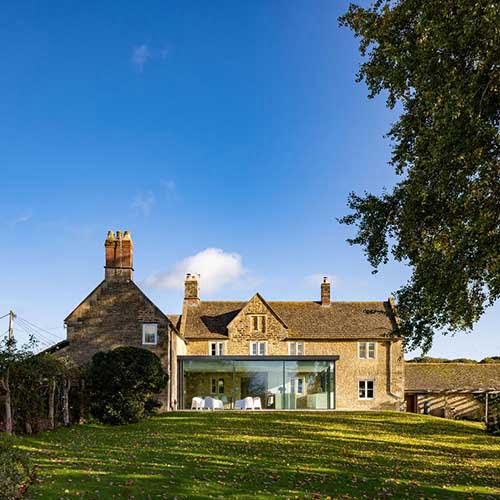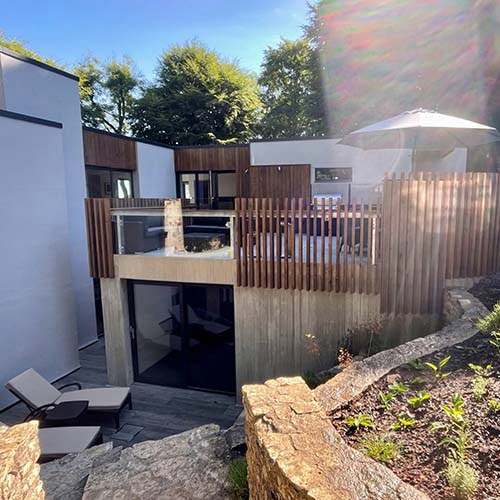Westlands FarmhouseA modern glass extension to a Listed building

Westlands Farmhouse is a contemporary extension to a Listed building, which replaces a 1980s conservatory. The Client had a strong desire to move their kitchen out from the confines of the thick stone walls which define the farmhouse, and out into the daylight. As with most family houses, the kitchen is the heart of all the daytime activity, so having it completely glazed, with 3 out of the five glass panels opening, it becomes a really versatile indoor / outdoor space from which to enjoy the daylight and fresh air of the garden.
The high spec glass door system and heavily insulated roof ensure that the new south facing extension does not overheat or suffer from excessive heat loss.
Quarry WoodExtension providing a new external space for a Modernist house

The existing house was originally a wartime RAF lookout position built into an old stone quarry overlooking Bristol from the Cotswold escarpment on the edge of the Bath. It was converted and extended in the 1970s in a unique design which very much reflected the forward looking client at the time.
The house is “upside down, with the entrance and living rooms all on the upper level, and bedrooms below. The living spaces did not therefore have direct access to any external space except for a large balcony on the (very exposed and windy) North side. The new extension is a sun-facing outside space linked with the living room, with a laundry room and gym below.
The new extension has been constructed from insitu board-marked, waterproof concrete, which allowed for minimal excavation (no working space behind the new wall) and a polished concrete structural slab – no waterproof membrane. The whole structure is insulated from the inside.
Willow LodgeContemporary design in a Cotswold village

Willow lodge is a small cottage built in 1908 and sits on the edge of the picturesque village green in Wiltshire. The property is not listed yet sits within a sensitive rural setting in the Cotswolds Area of Outstanding Natural Beauty. The house had a large and well kept rear garden but it was somewhat remote from the house – separated by a slightly sunken and dark, north facing patio with a cold and inadequate rear extension in it. The Client’s brief was simply to make the most of a challenging site and they were not afraid of a striking and contemporary design in this sensitive location.
Although the extension is on the north side of the house, the orientation of the openings provides south and east as well as north facing glazing and privacy from a rather overbearing neighbour. The east facing glazing provides a miniature courtyard to the east to take advantage of morning sunshine.
The complex form was made by constructing a series of plywood portal frames which were accurately modelled (and optimised structurally) using a parametric Rhino / Grasshopper model, which was then turned into a cutting pattern file for all the elements to be simply cut out using a CNC router. The pieces were numbered and delivered to site, where they were assembled using low tech screw and glue technology. The extension is clad in standing seam zinc cladding, in a manner which compliments the existing house and minimises the building’s whole life embodied carbon footprint.
Innox Lodge Bringing the garden into a historic home

Located on the edge of the village with wide views across the rural landscape, this unlisted Victorian house was recently renovated by its owners. They wished to add a new garden room that would link the kitchen with the surrounding landscape and provide a place where the family can gather informally. The contemporary design of the new addition remains sympathetic to its setting through the use of traditional materials including bath stone ashlar and pre-formed metal sheets that match those of the original house. In advance of the construction of the new space a number of alterations to the house were made including the creation of a large opening through to the kitchen and a new staircase into converted basement rooms below.
The Fosse Contemporary extension to historic house.

This Victorian villa in a village location has been altered on numerous occasions in the past, and the client purchased the house in a state of disrepair. The design concept of the new extension and whole house refurbishment work was to reverse the orientation of the house to create the entrance to the rear north elevation, allowing the elegant south façade and garden to become a private sanctuary for the family. The new contemporary double-height entrance hall looks over a newly excavated courtyard. This is lined with a rubble bath stone wall that wraps around the space and creates a roof terrace over the garage, penetrating through the new glass screen to form an internal first floor gallery, linking inside with outside.
Avenue Housing A back land development of 5 low cost homes

This development proposal responds to the need for small, low cost houses and flats in Minehead, whose economy is heavily dependent on seasonal work and retired people. Situated in the main street connecting the town centre to the beach, the scheme comprises the conversion of a Victorian former hotel and nursing home into seven private flats, some with private gardens, suitable for young or elderly couples. The former car park at the rear is to be developed as five small mews houses around a small parking yard, providing accommodation fitting for young families. The arrangement of shared facilities and common external circulation routes has been designed to encourage neighbours to meet and to get to know each other.
Bloomfield Avenue A modern garden room kitchen extension

Our brief in developing designs for this project was to replace a small galley kitchen, dark breakfast room, tired utility room and underused conservatory. The end result needed to be light and bright, provide a direct and open relationship between the house and garden, with enough space to function as a multi-purpose room where the family would spend much of their time together. Our proposal created a new open plan space which stretched across the back of the house containing kitchen and family room. We moved the family spaces closer to the garden and the light and utility room into the house where natural light was less important. Large areas of glazing bring high levels of natural daylight into the house. A full width sliding door and floor to ceiling window system blurs the boundary between inside and outside, bringing the garden into the house and making the garden more accessible and usable.
Cedar House A remodelled and extended home in a Conservation Area

The client had purchased a dilapidated 1950s house in a residential street in Bristol, and wanted to transform it into a modern, bright and low energy family home. After discussions about the merits of retaining all, part or none of the existing accommodation, it was decided to leave the front part of the house in tact with a new extension to the rear. The retained section was renovated and included a new slate roof, metal windows and was overclad with insulating render to improve the thermal performance. The rear of the house took on a softer character using western red cedar cladding and contained the new heart of the house; a double height dining space with direct access into the kitchen and a new staircase leading to a first floor gallery.
Sydney Buildings Modern extension of a listed house

Sydney Buildings is a desirable street on the southern slopes of central Bath. Our client purchased a run-down listed property previously used as student accommodation with the aspiration to return it back into a family home. After careful analysis of the historic value of various aspects of the building fabric, we prepared a scheme that stripped away the modern layers of inappropriate interventions, repaired original features and sensitively introduced new services to make the house fit for modern life. The highlight is the new contemporary double-height bay window in the basement that opens out into the garden providing views across the Kennet and Avon Canal to the city skyline beyond.
Monkton Farleigh Timber framed extension to Listed Cottage

The project involved the refurbishment and extension of a grade II listed cottage in the picturesque village of Monkton Farleigh (Green Belt and AONB). One of a row of two, formally three cottages, the building had been extensively remodelled and was badly in need of modernisation. Challenges included a flying freehold over the neighbouring cottage. Designscape were appointed as having the knowledge and experience best suited to the owner’s needs and objectives. The brief was to undertake a sympathetic renovation of the house, strip out modern alterations, make minor modifications to the layout, upgrade building services, and where feasible, upgrade the building fabric. The attic became a main bedroom suite and a poorly constructed C20th extension replaced with a new design built to a high standard and making the most of the garden and views across the fields beyond. The result is a series of high quality, light, airy, warm and healthy living spaces which retain and enhance much of the old character, whilst adding a new layer which will age sympathetically with the dwelling. The project stands out in achieving a successful marriage of thoughtful design, an understanding client, and some conscientious workmanship from the builder which in our experience is a rare commodity in projects of this scale and complexity.




